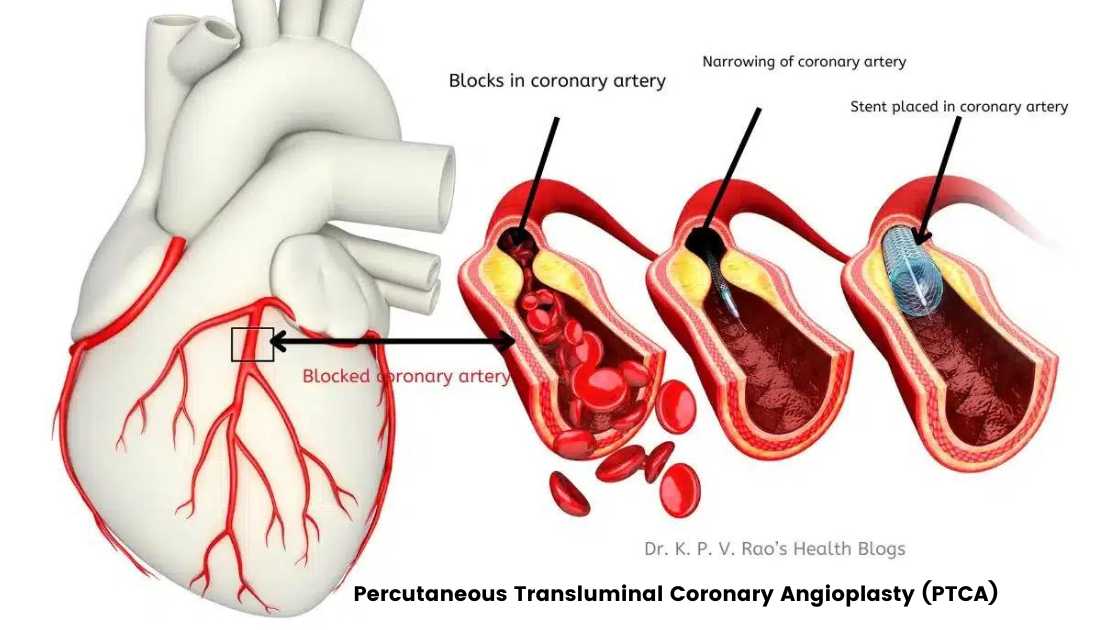Introduction to Percutaneous Transluminal Coronary Angioplasty (PTCA)
Imagine you getting a mild chest pain, a few burps and you feel uneasy. You tell your spouse/son/daughter or whoever is nearby about this, and they say-” It’s nothing, maybe a bit of acidity” and they give chewable antacid tablet or a syrup like Gelusil, you feel a bit relaxed and again the pain reappears after some time. And you feel really very uneasy; this time whoever is near you will say “let’s go to the doctor”.
You reach your doctor’s clinic or if the doctor is not available, you call him for a home visit [this happens to me many times-patients calling me home at odd hours]. Your doctor checks you thoroughly and after a few minutes declares- “I think we should visit the hospital”.
You visit the emergency room of the hospital, they take out an ECG and you are told that you just had a heart attack! The emergency room staff swings into action, a cardiologist is called, and an emergency angiography is carried out, which shows you have blocks in the arteries supplying blood and much needed oxygen to your heart, causing less blood supply or no blood supply to heart muscle.
Your cardiologist doctor now gives you two options- “You need urgent stenting or bypass surgery- which should it be?” Obviously, you are not prepared for such a situation, and you definitely don’t want to go in for surgery. You prefer stenting and this stenting- placing a mesh-like tube in the artery- is called Percutaneous Transluminal Coronary Angioplasty.
Your stenting is done, blood supply to your heart is restored and you walk out of the hospital after a day or two’s stay without any chest pain.
So, let’s now learn about this lifesaving procedure in detail. For the sake of convenience, I have split this article into two parts. In this part we discuss how the procedure is done and in the second part, we will learn about benefits and precautions to be taken pre-op and post-op and to prevent any untowards complications of this procedure.
What exactly is Percutaneous Transluminal Coronary Angioplasty or PTCA?
Percutaneous Transluminal Coronary Angioplasty (PTCA) is a minimally invasive procedure designed to open up blocked coronary arteries, thereby enhancing blood flow to the heart muscle.
This technique has become an essential tool in the management of coronary artery disease (CAD), a condition characterized by the narrowing or blockage of the coronary arteries due to the buildup of atherosclerotic plaques.
CAD is a significant cause of morbidity and mortality worldwide, and PTCA plays a crucial role in alleviating the symptoms associated with this disease, such as chest pain and shortness of breath.
Recently, I wrote an article on heart angiography that helped a heart disease patient to get a coronary artery bypass surgery done.
PTCA involves the insertion of a small balloon catheter into the narrowed segment of the artery. Once in position, the balloon is inflated to compress the plaque against the artery wall, effectively widening the vessel and restoring adequate blood flow. In many cases, a stent—a small, wire mesh tube (as shown in the image below—is placed at the site of the blockage to keep the artery open long-term.

History of angioplasty
The history of angioplasty dates back to the late 1970s when Dr. Andreas Gruentzig performed the first successful PTCA. Since then, the technique has undergone significant advancements.
Innovations such as drug-eluting stents (stents that release medicine), improved imaging techniques, and the development of specialized catheters have made the procedure safer and more effective.
PTCA is now a cornerstone in the treatment of coronary artery disease, often preferred over more invasive surgical options like coronary artery bypass grafting (CABG).
How PTCA Works: The Procedure Explained
Percutaneous Transluminal Coronary Angioplasty (PTCA) is a minimally invasive procedure aimed at alleviating blockages in the coronary arteries to improve blood flow to the heart. The process begins with a comprehensive patient assessment, which includes:
- evaluating medical history,
- physical examination, and
- diagnostic tests such as an electrocardiogram (ECG) and coronary angiography. These steps ensure the patient is a suitable candidate for PTCA.
This procedure is carried out in a place called Cath Lab, in the cardiac (heart) department of the hospital.
Prior to the procedure, patients are typically administered medications to minimize the risk of complications.
Antiplatelet drugs, such as aspirin or clopidogrel, are commonly prescribed to prevent blood clot formation post the procedure.
Additionally, sedatives may be given to help the patient relax, and local anesthesia is applied to numb the insertion site, usually the groin or wrist.
PTCA procedure-how is it done
The procedure itself involves the use of a catheter, a thin, flexible tube that is inserted through an numbed area in the groin (most cases) and navigated through the blood vessel (the femoral vein) to the site of the arterial blockage in the heart.
The catheter’s progress is monitored using real-time X-ray imaging, known as fluoroscopy. Once the catheter reaches the blockage, a specialized balloon attached to its tip is carefully inflated.
This inflation compresses the plaque (cholesterol deposits in the arteries) against the artery walls, thereby widening the narrowed artery and restoring blood flow.

In many cases, a stent—a small, mesh-like tube—is placed at the site of the blockage (see the picture above). The stent is delivered via the balloon catheter and expanded as the balloon inflates.
Once in position, the stent helps keep the artery open by providing structural support. The balloon is then deflated and removed, leaving the stent in place.
The entire PTCA procedure typically lasts between 30 minutes to two hours, depending on the complexity of the blockage and whether multiple arteries are treated.
Local anesthesia and mild sedation are usually sufficient, allowing the patient to remain conscious but comfortable throughout the process.
After the procedure, patients are monitored for several hours in the ICCU of the hospital to ensure there are no immediate complications before being discharged.
To be continued …..
Having learned about what PTCA is, we will now learn how to take care after the procedure has been completed, in my my next article.
References:
Final Words
I hope I was able to answer all your doubts about PTCA so far. If yes, do join subscribe to my notifications to get notified about my latest articles. Do share this article on your social media channels. You can also try tweeting it here-
Understanding Percutaneous Transluminal Coronary Angioplasty (PTCA): A Comprehensive Guide Share on XWe will continue to learn more about PTCA in the next article which will be published immediately after this one. You can read it here- Benefits, Risks and Post PTCA care.
Adios.




